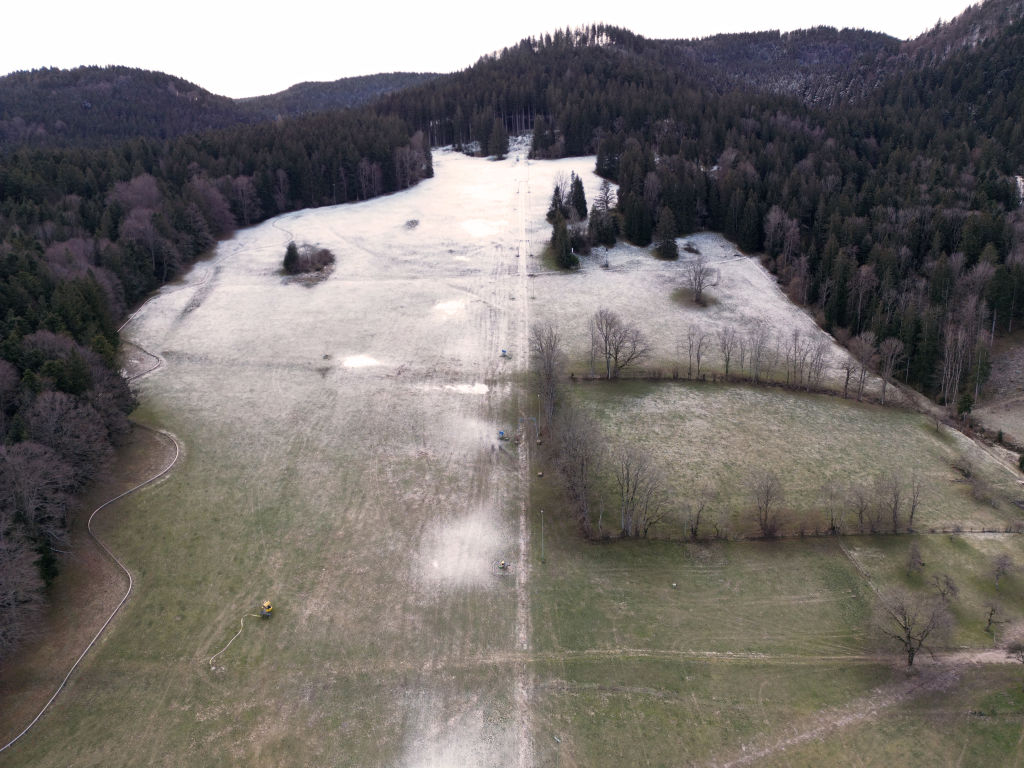“How Climate Change Helped Europe Avoid Russian Aggression This Winter”
Ski lift without snow in Bavaria
Patches of snow lie around the parked snow cannons on a ski slope in the Oedberg ski area in Bavaria. Credit – Peter Kneffel/dpa
Climate change has kept Europe warm enough this winter to save it from Russian President Vladimir Putin’s energy crisis, but the respite could prove fleeting if — maybe when — the same climate changes cause a crisis this summer. A warm and dry winter usually means a hot and dry summer, and Europe’s near-term relief could prevent the continent from preparing for the next wave of energy crises.
Last year saw record-breaking heat across much of the world and a historically mild winter like this does not bode well for summer temperatures to come in Europe. With less winter snow and therefore less snowmelt, and hotter and drier weather leading to more evaporation and higher electricity consumption for cooling, the summer of 2023 could once again confuse European and global energy markets, leaving Europe ill-prepared for the next winter.
The immediate impact of a largely snowless and warm winter on the likely summer energy situation is limited power generation. In 2022, severe droughts across Europe caused a massive drop in water levels in rivers and lakes. Portugal’s reservoirs, for example, were only 29% utilized in summer by the end of July 2022. Many others across Europe fell to the point where hydroelectric power plants could not operate fully or at all. Spain’s hydroelectric power generation fell by over 53% and large hydroelectric plants had to close. Italy’s declined 37.7%. France’s overall electricity generation hit an all-time low, with hydropower outages of 22% due to equally record-low water levels. This is purely a sample.
The water level is important to keep the light on. In 2020 and 2021, hydropower accounted for around 17% of electricity in the EU. If this summer even approaches the heat and drought of 2022, Europe could lose double-digit generation capacity. And of course Europe enters this summer with water levels devastated from last year. The forecasts assume that it will be hotter than last year. The UK’s official weather service, the Met Office, expects the La Niña cooling pattern that has been in effect for the past three years to unravel, leading to higher global temperatures. Others agree. But even if it doesn’t get any hotter, it’s going to be drier this winter due to record low snowfall so far.
However, hydropower is not only important as a generating capacity. It also provides grid stabilization services because it can be more flexible – “dispatchable” – than other types of energy. That’s because a dam can be opened or closed at will to drain water from the reservoir behind it, while other energy sources require fuel or cooperative weather. This on-demand potential enables battery-like storage services. Hydropower is more reliable than wind, solar, or fossil fuels, and cheaper than any other power source. The loss of this price advantage, grid stabilization and controllable hydropower supply will increase electricity prices and reduce grid efficiency in Europe.
In the meantime, the consequences of low water also have an impact on other power generation. Nuclear power, for example, requires water for cooling. If the water level gets too low, nuclear power generation can become risky. France, which normally gets over 70% of its electricity from nuclear power, had to reduce the output of some nuclear power plants in 2022 because of the drought (and others for maintenance work). Likewise, rivers depleted by drought can affect coal production. Fewer coal barges can navigate Europe’s waterways when there is no water in them. In 2022, Germany, among others, had to close some operations in coal-fired power plants due to coal shortages due to shipping bottlenecks due to river shrinkage.
In turn, lower generation from hydro, nuclear and coal means more natural gas has to be burned to make up the difference. Wind and sun can partially compensate, but how much depends on the weather. Even at full capacity, these renewable sources together account for only about 25% of the block’s total power mix. Although Europe’s gas storage levels are currently at record highs due to frenetic 2022 buying and the mild winter, the equally extreme summer impact of climate change could force Europe to burn enough gas to work off its current surplus, and do so just before next winter. Peak power consumption due to cooling needs during heat waves will contribute to this.
Exactly what impact all this will have on energy prices and market stability is difficult to predict, but significant volatility and at least some price increases are more than likely. The extent of this will depend on how tight the world is with natural gas, oil, coal and other fuels, and of course the weather – as well as unforeseen emergencies or crises, such as if workers’ strikes flare up again at France’s nuclear power plants, or if Putin is assassinated or if China invades Taiwan.
Other variables at play are how quickly China gets its industrial sectors back up and running after years of COVID-19 lockdowns, with China’s resurgence expected to weigh heavily on demand for global energy commodities. Europe’s success in meeting its 2022 natural gas storage targets despite Russian export cuts and the continent’s own bans on Russian energy was largely due to China remaining shut. This reduced global demand and allowed Europe to stockpile LNG, albeit at astronomical costs. In 2023, China’s reopening will divert much of the world’s liquefied natural gas (LNG) trade away from Europe and push up prices globally, meaning Europe could struggle to replace the gas it burned this summer.
Another question is whether Saudi Arabia and other OPEC countries will reduce, maintain or increase crude oil production in 2023. These decisions are being made to keep prices high by restricting supply, which obviously affects oil prices specifically, but with knock-on effects on other energy supply chains. OPEC cut production in October 2022 for all of 2023, citing “a period of heightened uncertainty and growing challenges amid persistently high inflation rates, monetary tightening by major central banks, high government debt in many regions, and ongoing supply problems.” Further adjustments in 2023 could shock markets. Such a decision, while not expected, could be based on what Russia is doing.
This is the third big unknown, whether the Kremlin will react to the various sanctions and price caps in the western world for Russian energy products with further restrictions on production or a diversion of exports. If that is the case, the ensuing energy crisis — no longer a crisis because Putin has already lost the energy war — could unsettle energy markets again, as Europe still imports over 17 billion cubic meters (bcm) equivalent of its LNG from Russia. In fact, Europe imported 12% more Russian LNG in 2022 than in 2021. There is no European ban on Russian LNG yet. The continent is also hooked on Russian diesel, although a ban on refined oil products from Russia comes into effect on February 5, 2023. The US cannot compensate for the end of Russian diesel due to refining capacity and new refineries in the Middle East will not come online before 2024, so expect some market turbulence. Each of these represents a potential pressure point for Putin to further pressure global energy markets.
Russian oil is also involved. India and China in particular are also big buyers of Russian crude, and Russia now mainly relies on them as energy customers. Against this backdrop, the western price cap of $60 for Russian crude appears to be working at first glance, as most Russian oil is sold below this threshold. That could prompt Moscow to cut output anyway, or maintain or increase it to try to fill the budget gap. However, a more in-depth analysis of the price caps suggests that they don’t really hurt Russian energy profits as different crude oils are sold in different global markets. Either way, it doesn’t get any easier to predict Putin’s energy aggression.
What is certain is that global energy and other resource shortages will continue into 2023 and likely into 2024, if not beyond. With supplies running low, surprises, emergencies, strikes, major storms, accidents or other unforeseen events will shake markets. Electricity prices will fluctuate unpredictably, as will the prices for fuels such as natural gas.
Despite Europe outmaneuvering Putin this winter, ironically aided by the climate catastrophe it has vowed to flee and to which Russian fossil fuels have contributed greatly, the next 12 months may not prove any easier, whether the Kremlin is still has a lot of energy leverage. This winter’s mildness will see Europe as a double-edged sword if the coming summer follows the trend of record-breaking temperature highs. While the continent won the climate change lottery this winter, the chances of it winning twice in a row are slim, especially when a second win depends on the unlikely decline of the same climate change dynamics.
Don’t miss interesting posts on Famousbio









